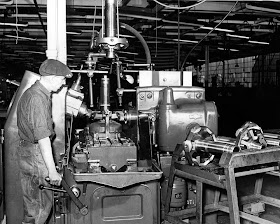 |
| The prop-shaft in a fully assembled engine, in Chicago. The shaft is protruding directly out the front of the engine, under the workers left hand. |
 |
| Adding the "rear bulkhead" cover for the planetary (bevel) prop-shaft at the Buick plant in Chicago. |
 |
| Assembly of the planetary bevel gear at the Buick Melrose plant. |
 |
| This photo that I took at the Sloan museum in Flint, Michigan shows the prop-shaft assembled and in it's proper place in the "nose section". |
 |
| One of many propaganda posters that were found throughout the factories. |
 |
| Parts ready for delivery to the Buick Melrose assembly plant in Chicago. Prop-shaft on the left, master rod in the middle and crankshaft on the right. |
 |
| Much inspection taking place on this critical part. |
 |
| Finished prop-shaft. Or raw housing for a bevel planetary unit. "Assembly took place at Buick in Chicago". |
 |
| Cutting the splines and test fitting the area that the propeller unit will fit to. |
 |
| Some difficult inside lathe work on the surface where the planetary gears will ride. More of this work is shown farther below. |
 |
| Grinding the outside edge. |
 |
| Milling on the bevel edge. |
 |
| This looks like a vertical lathe at work. |
 |
| Grinding on the outside bevel. Same worker shown twice farther below, doing the same operation. |
 |
| Drilling and inspecting. |
 |
| Some difficult inside lathe work on the surface where the planetary gears will ride. |
 |
| Grinding on the outside bevel. |
 |
| Adding the inside holes where the pins for locking in the planetary gears will fit. |
 |
| Grinding on the outside bevel. |
 |
| Milling or grinding the inside surface where the planetary gear will ride. |
 |
| More drilling foe the gear pins to fit into. |
 |
| Rough grinding the shaft into a taper. |
 |
| Rough grinding the shaft into a taper. |
 |
| More shaft machining on a lathe. |
 |
| Drilling two prop-shafts at the same time. |
 |
The bevel has now been roughed in.
More lathe work.
|
 |
| First "roughing in" on a lathe. |
 |
| The prop-shaft with what I believe to be some sort of Colet used during the machining process. |
 |
| I believe this to be a forged part made in factory #03. I also think, but can't confirm yet that this is the same chromium-nickel-molybdenum steel that the crankshaft is forged from. |
 |
| The prop-shaft for the Liberator engine on it's way to heat treat. I looked ay numerous photos and believe this to be in the factory #03 complex of buildings (the forge plant). |
Links:


No comments:
Post a Comment